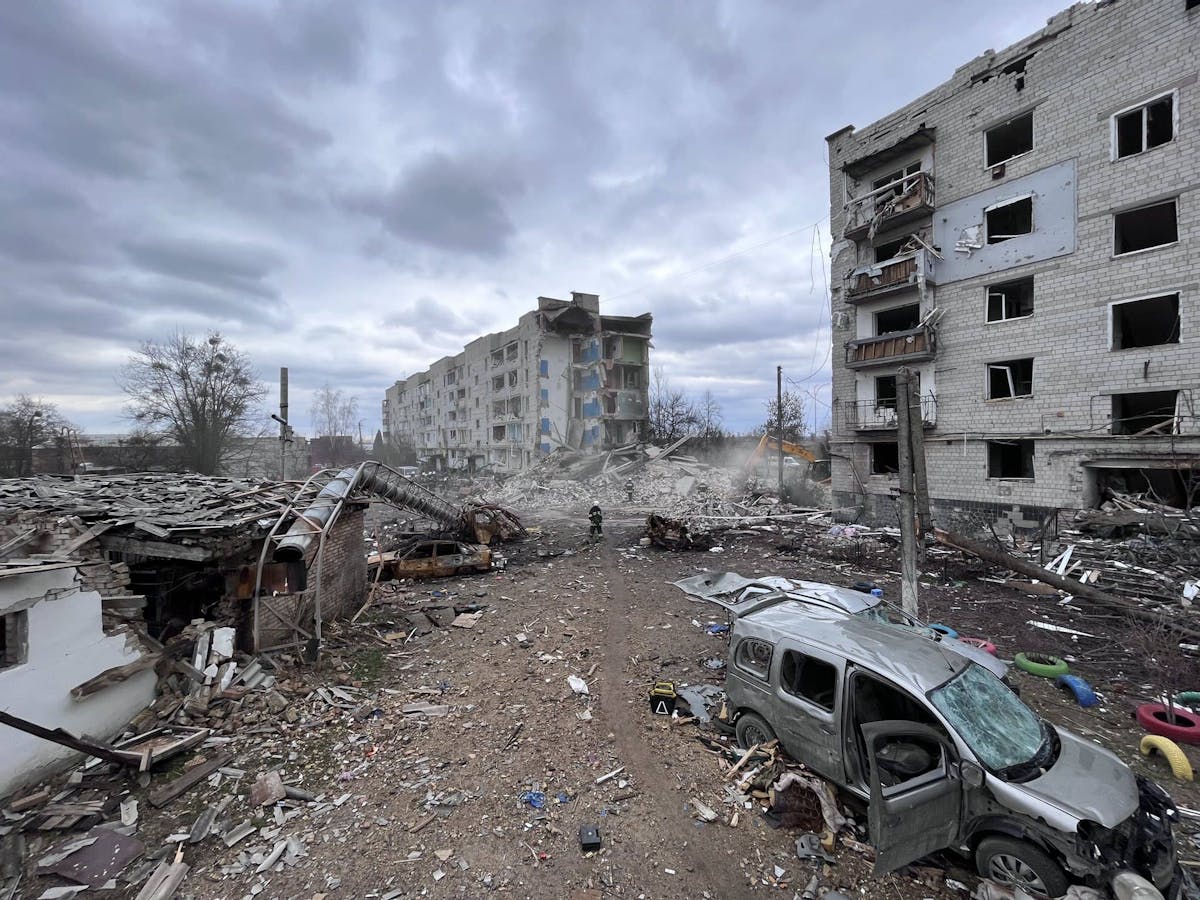Russians’ Retreat Leaves Their Barbarity Everywhere Evident Around Kyiv
Busted wooden ammunition crates are in a corner next to a smashed television. Slapdash sleeping places are arbitrarily arranged on the floor, made of blankets, sheets, rolls of carpeting, rugs, and bundles of clothes. At least 17 Russian soldiers slept here.

KYIV, Ukraine — The rout of the Russians around Ukraine’s capital city is complete. Stalled at the city’s outskirts — low on fuel, food, and morale — Russian troops beat a hasty retreat northward and across the border into Belarus.
The Russian retreat from the city’s outskirts, suburbs, and small satellite cities paint a picture of unfettered brutality: a way of war that makes little distinction between enemy combatant and civilian and plunders with wanton disregard for human life.
In Irpin, a small satellite city just outside Kyiv, Russian brutality was on full display. Burned, decimated remains of buildings are virtually the only remaining structures in the city center, hollow shells that stand over mountains of rubble.
A rescue crew explains to reporters that the Russians hit the buildings during their retreat, many with families still living inside. Even if some survive the initial strike, those buried beneath the rubble have little chance of making it out.
Veteran war correspondents note that it is not uncommon to find unexploded ordnance in the aftermath of previous Russian strikes. This reporter has seen the phenomenon first-hand at Mykolaiv in Ukraine’s south.
Thanks to the propensity for Russian munitions to survive an initial strike intact, rescue crews are forced to wait for explosive ordnance disposal personnel to comb through buildings and bomb sites. This can take anywhere from hours to days.
Those few fortunate enough to survive a missile strike must contend with dehydration and hypothermia and face long odds of survival. A rescue worker tearfully explains that there is “little hope” for anyone buried here.
The destruction in Bucha, a town just northwest of Irpin, is total. Amidst several destroyed Russian armored vehicles, piles of abandoned ammunition, and decimated houses, tell-tale signs of the Russian occupation are quickly apparent.
“Дагестан” is spray-painted in red letters at a bus stop — Dagestan — a Russian region sandwiched between Georgia, Azerbaijan, and the Black Sea. Large letter “V”s are sprayed on buildings and vehicles, a symbol of Russia’s war in Ukraine.
A Ukrainian mother explains that the Russians used a large, gated community kindergarten as a staging area for armored vehicles. Piles of oily engine and transmission parts are scattered around the compound, haphazardly mixed up with torn reams of grass sod, ripped up by the tracked vehicles.
Trash is littered around the compound: empty bottles of engine oil, soiled uniforms, and spent ammunition casings. Several vehicle transmissions and an engine block are also dispersed around the kindergarten.
Two sets of rusted tracks from an infantry fighting vehicle are in the compound’s center, and aluminum vehicle benches are casually discarded. The rank smell of feces and urine permeates the kindergarten’s edges.
A group of children plays amid the discarded Russian detritus, and several of their mothers show us the kindergarten basement where they sheltered. More than 400 people sheltered in the small space, a bearded man in the basement explains over candlelight. Although the Russians are gone, he chooses to remain underground.
A column of smashed Russian armored vehicles lies on a residential street. The vehicles are orange, steel oxidized by intense heat and exposure to the air. The insides are a mangled wreck of distorted steel. Anything flammable, even bodies, has been turned to ash.
Several of the armored vehicles’ roofs are nowhere to be seen, perhaps vaporized by internal explosions. Red flags mark where unexploded mortar rounds are buried in the asphalt.
Signs spray painted onto corrugated iron fencing in Russian and Ukrainian mark property that has been mined and boobytrapped by the Russians in their retreat. Ukrainian officials estimate it will be years before Ukraine’s urban areas are entirely demined.
Halyna is sitting outside the Church of St. Andrew. She will be 82 this month and is part of the choir. She describes how her son, daughter-in-law, and two grandsons fled their house after it was hit by Russian fire.
Leaving the house wasn’t easy — one of her grandsons is paralyzed from a pre-war accident. As they fled down the street, a gas tank near them exploded, hit by Russian fire. All four family members suffered burns to their faces and arms.
Their house is completely destroyed, and they don’t have a car, but they’re alive, Halyna explains. The Russians executed many in Bucha. There is a trench behind the church full of bodies, Ukrainians killed by the Russians. Some bodies are bagged, some are not.
Halyna becomes emotional but insists I take bread and a sausage from her bag. She asks for our names on a piece of paper so she could pray for us at church.
Not far from the destroyed Russian vehicles, a large house’s spacious garden has been driven through by a tracked vehicle — its tracks plowed deep furrows through a carefully tilled vegetable patch.
The house’s Ukrainian residents must have been relatively well-off. The garage next to the two-story home has a small apartment built above it, but the property is clearly abandoned.
Russian soldiers lived in this house. The path approaching the home is littered with the leftovers of Russian army rations, packaged into dark green, shoebox-sided cardboard boxes.
Much of the food is half-eaten and carelessly cast aside: bags of crackers, tins of bacon, containers of mixed vegetables, beef with buckwheat, and liver paste are scattered around the property.
A staircase next to the house leads to a dark below-ground basement. Sacks of potatoes, crates of onions, and jars of pickled vegetables line the walls. The floor is rough-hewn wooden planks, and winter coats are arranged on the floor into ersatz bedding.
The coats are a mixture of faux fur, puffy pastel parkas, and thick padded leather bomber jackets, clearly articles of civilian clothing likely taken from the house owners.
The level of filth in the dank cellar is incredible. The blankets on a pop-out sofa bed in the basement are covered in grime. Greasy, off-white pillows lie on top of the bed.
Old boots, partially eaten rations, and discarded clothing litter the floor, and the shelves from a pair of refrigerators are ripped out, contents spilled out onto the floor.
A large pail in the basement hallway is nearly overflowing with what appears to be human excrement and cigarette butts.
Busted wooden ammunition crates are in a corner next to a smashed television. Slapdash sleeping places are arbitrarily arranged on the floor, made of blankets, sheets, rolls of carpeting, rugs, and bundles of clothes. At least 17 Russian soldiers slept here.
In their haste to leave, the Russians left behind clues about who they were and where they came from. A discarded uniform and unit patch discloses which forces ransacked and occupied this house: Russia’s 234th Guards Air Assault Regiment, stationed at Pskov, 40 miles from the Estonian and Latvian border.
Personal effects litter the backyard: empty wallets and purses, a backpack, broken tablets, and cellphones. A tool shed in the back has been ransacked, and its power tools are gone.
A well-worn pair of maps of Ukraine lie on the patio table — Russian-language road atlases, printed in 2001.
Across the street, another house bears evidence of the Russian occupation. The two-story house is caved in and burned down. Seared brick walls and drooping roof tiling are the only parts of the building fire hasn’t destroyed.
The Russians had access to a prodigious amount of alcohol, evidenced by tens of dozens of liquor and beer bottles in a pile next to the front door. A looted safe lies face-up in the front yard, the heavy door ripped from its hinges. Save for some small change, it is empty.
Noting apparent interest in the buildings, a passer-by explains the history of the two properties. He declines to give his name but explains that the pair of houses served as a local headquarters for the Russians.
The man explains that a mother and father lived here, nodding at the burned-out house. Their daughter lived across the street at the house with the garden. Although he doesn’t know what happened to the mother or daughter, he knows what happened to the father.
During the Russian invasion of their city, the couple sheltered in a brick-lined underground storeroom next to the house. Like the daughter’s basement, the storeroom held preserves, potatoes, and other foodstuffs.
The Russians called the husband out from the underground room, the man explained, telling the wife to stay underground. Although he doesn’t know what the Russians said to the man, he knows what happened to him. The Russians shot him in the yard.
The man points to a neatly tilled vegetable patch next to the house. A crude wooden Russian cross in the center of the patch towers over the new green shoots that poke above the ground, marking where the wife buried her murdered husband.

